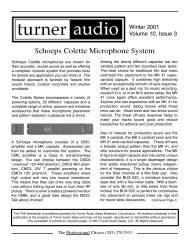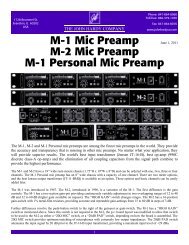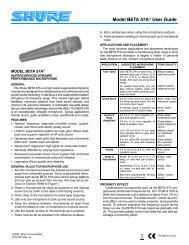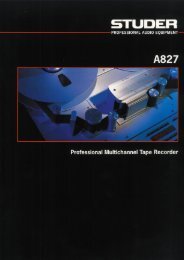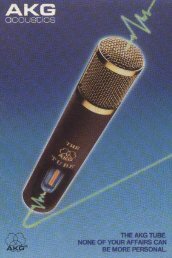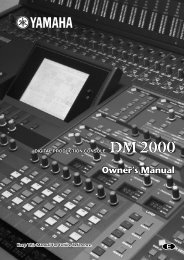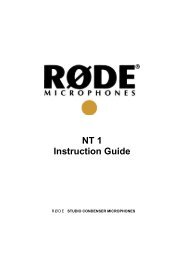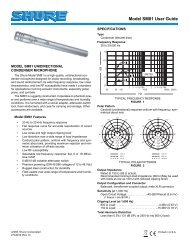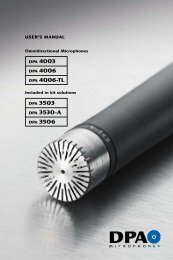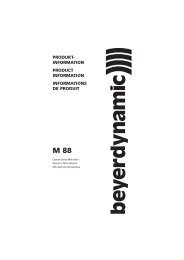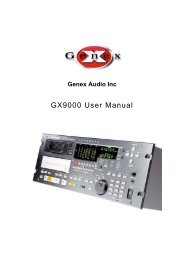Lexicon 480L | PDF - Freeverb3
Lexicon 480L | PDF - Freeverb3
Lexicon 480L | PDF - Freeverb3
You also want an ePaper? Increase the reach of your titles
YUMPU automatically turns print PDFs into web optimized ePapers that Google loves.
<strong>Lexicon</strong> <strong>480L</strong> Owner's Manual<br />
Page One<br />
CH1<br />
Left Channel In<br />
CH2<br />
Right Channel In<br />
EFF<br />
Effect<br />
ANG<br />
Speaker Angle<br />
LFB<br />
L-R Boost<br />
MIX<br />
Dry Input<br />
The Panorama (Binauaral) Program<br />
Panorama is a crosstalk elimination program. It increases<br />
the apparent width of stereo sounds by eliminating<br />
the crosstalk around the ears of the listener. One<br />
of the major uses of this program in the <strong>480L</strong> is to<br />
spread the sound of a reverb or effect outside the<br />
bounds of the loudspeakers. This is easily done with a<br />
mixing board by putting the <strong>480L</strong> in cascade mode with<br />
Ambience or a reverb program in machine A, and<br />
Panorama in machine B. The mix control in machine A<br />
should be ALL EFFECTS. In machine B the Effect<br />
control and the Low frequency width are used to<br />
increase the width of the reverb, and the Dry Input Mix<br />
control or an external mixer can be used to add the<br />
unexpanded original sound back into the expanded<br />
reverb.<br />
In making expanded recordings the listener is assumed<br />
to be exactly between the two loudspeakers,<br />
and the speakers should be at the angle set in the<br />
program. For this reason, this expansion is best done<br />
at the time of playback, using a home processor.<br />
However, there may be good reasons for doing some<br />
expansion in a recording. Low frequencies are spread<br />
by the program through the whole listening room —<br />
they do not require precise adjustment. Even under<br />
non-ideal playback conditions, some improvement<br />
may be noted. Recordings made with ORTF, or closely<br />
spaced omni microphone techniques, will probably<br />
greatly benefit from some LF L-R boost, which can be<br />
adjusted independently from the crosstalk cancellation<br />
controlled by the EFFECT control.<br />
This program may also be of use to professionals using<br />
Binaural recordings to study acoustic or noise environments.<br />
Binaural recordings played with Panorama<br />
through a carefully set up loudspeaker system give<br />
nearly ideal reproduction of the original recorded<br />
sound field, at least in the front hemisphere.<br />
Setting up the program for this application is best done<br />
with a noise source at the input. Use CH1 to turn off the<br />
left input level, and move your head to find a position<br />
which gives a sharp null in the left ear. Now raise CH1<br />
and lower CH2. The null should now be in the right ear.<br />
If it is not, adjust ANG and the listening position until a<br />
sharp null occurs for each ear.<br />
About the parameters<br />
CH1, CH2 (Left In, Right In)<br />
These controls are simple linear attenuators on the left<br />
and right inputs. They can be used to set up the<br />
program, or they can be used as input balance controls.<br />
They can also be used to trim the balance into the<br />
L-R boost control.<br />
EFF (Effect)<br />
EFF sets the amount of crosstalk cancellation in the<br />
mid frequencies, and acts as a width control. If EFF is<br />
set to 0, and L-R boost is also set to 0, the program has<br />
no effect on the sound.<br />
ANG (Speaker Angle)<br />
ANG sets the speaker angle expected in the listening<br />
environment. This is the total angle between the speakers.<br />
Lower settings of the speaker angle control (40° or<br />
so) are more effective when the actual speaker positions<br />
to be used by the listener are unknown. This is<br />
because most listeners tend to use smaller speaker<br />
angles, and because the effective listening area is<br />
greater when ANG is low.<br />
LFB (LF-LR BOOST)<br />
LFB is a L-R bass boost with a maximum boost of 20dB.<br />
It is similar to the Spatial Eq control in Stereo Adjust, but<br />
works differently. It is a pure boost in the difference<br />
channel only. It does not affect the mono channel. If<br />
Panorama is being used to process a binaural recording<br />
for loudspeaker reproduction, LFB should be at<br />
least half-way up. This control is independent of EFF,<br />
so the low frequency width can be increased without<br />
changing the mid-frequency width.<br />
8-10


